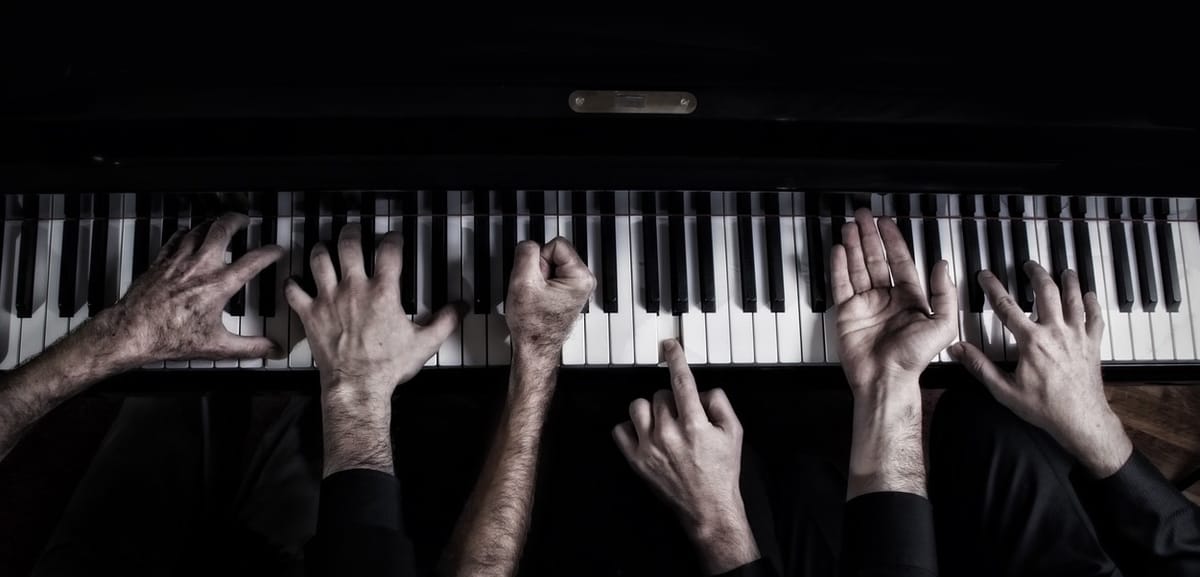Tools for Group Piano Online

The advent of COVID-19 has forced teachers to move group piano instruction online. While the online medium is not ideal to teach performance skills, there is a silver lining.
Online learning does present many benefits; chief among them is the great degree of flexibility it gives students and teachers. Students can watch and read instructional material at their own pace, as many times as needed, before submitting their work; teachers can create materials once, and deliver it repeatedly to the students whenever needed; they can assess and provide feedback at their own pace as well, and teach from anywhere in the world. Because of these advantages, some of us have been exploring group piano online for some time, even before COVID-19. In my case, I have offered summer online piano courses for non-majors at CU Boulder since 2016.
One of the most problematic aspects of teaching group piano online is that the natural and frequent student interaction we are so accustomed to is difficult to attain. Face-to-face interaction in traditional settings allows students to help/teach each other, develop critical listening skills, learn to speak intelligently about music and performance, and develop functional skills like ensemble playing or improvisation.1 In short, traditional group classes allow for the incorporation of effective cooperative learning opportunities.2 In online teaching, the teacher must use technology in creative ways to create student-to-student engagement and to mitigate the impossibility of in-person interaction.
There exist two global modalities of online instruction: synchronous and asynchronous. Synchronous instruction occurs when the teacher and the student(s) interact in real time with one another through video conferencing. Asynchronous learning relies on the exchange of videos and materials through online repositories. The parties involved in asynchronous instruction interact, view, read, or respond to the material at their own pace, in a time-shifted fashion.
Common tools used for synchronous instruction include video conferencing platforms like Zoom, Skype, FaceTime or Google Hangouts, among others. There are many good tutorials on how to optimize them for music teaching (see, for example, this video on Zoom). You can also find information about different setups and equipment in several excellent webinars offered by the Frances Clark Center in the last month.
Unfortunately, video conferencing is only effective if the parties involved have reliable internet and equipment. In a group situation, potential issues become much more probable when you have a large number of people participating in the conference. To put it bluntly, large group meetings online are not very efficient or easy to run. For these reasons, I decided to rely mostly on asynchronous tools for our online group piano classes at CU Boulder. Students are still able to “meet” with me during office hours. However, if desired, it is possible to schedule online class meetings where the instructor or students play back pre-recorded materials for feedback or discussion.
Creating Instructional Videos
In asynchronous instruction, teachers rely on digital files and videos to deliver information and to model. It is important that instructors plan their instructional videos carefully. I usually write down a rough script and a list of the different “scenes” to help me decide exactly what I will show and say, how many takes I will need, which camera angles to use, etc. Videos should be as short and succinct as possible (preferably shorter than ten minutes), and they should address one, and only one, topic per video. A number of software tools are available for producing these videos and extensive online tutorials. This list is not exhaustive, and it shows them from simplest to most complex:
- Recording video
- Zoom, while originally intended for video conferencing, has the ability to record the screen and the webcam in your device
- Quicktime Player (Mac) and Camera App (Windows, Android, iOS)
- OBS (free, Windows and Mac, https://obsproject.com/)
- Camtasia ($) and ScreenFlow ($)
- Capturing the screen with voice over
- Zoom
- Quicktime Player (Mac) and Game Bar (Windows 10)
- OBS
- Camtasia ($) and ScreenFlow ($)
- Editing video (trimming, clipping, superimposing, adding captions)
- Camtasia ($) and ScreenFlow ($)
You can find an example of an edited video with multiple cameras and screen capture here which I created using Camtasia.
Sharing of Material, Files and Videos
Most universities use robust Learning Management Systems such as Canvas or Blackboard to allow teachers to post materials and videos, create discussion opportunities, and track student engagement. These platforms also allow students to submit and share their performance videos and to comment on each other’s performances inside discussion groups.
Instructors teaching outside higher education have a few other choices to exchange videos and materials and create interaction:
- Shared folders and documents in Google Drive, Dropbox, or other cloud providers
- Closed Facebook groups
- Collabra (available at collabramusic.com)
Collabra has been recently redesigned. It is a comprehensive closed platform that allows teachers to create groups, post and share video “lessons,” assess and annotate student videos, and track student practice. Students use the platform to record their practice and performances, and share those with the teacher or group. Collabra is offering free access until May 2020. Watch a thorough tutorial and demo here.
Additional Tools
Annotating Videos
Time-stamped video annotations are an effective way to share comments and feedback with students, and to allow students to comment on their own or another student’s videos. The time stamp makes it easy to know the exact point of the video to which the comment refers. These are some of the tools used to annotate videos:
- Dropbox (paid account). Users can insert time-stamped comments to videos stored in the user’s Dropbox storage.
- VideoAnt (ant.umn.edu), ReClipped.com and Timeline.ly. These three platforms allow users to create time-stamped annotations to videos stored in different cloud providers, without altering, downloading or copying the original videos.
- VideoAnt and Timeline.ly can annotate public or unlisted Youtube videos. See a short demo of VideoAnt here.
- ReClipped can annotate public or unlisted videos on Youtube, Vimeo and other platforms.
Computer Feedback
Piano Marvel (pianomarvel.com) is an interactive platform that offers, among other features, an online method book with pieces ranging from elementary to advanced. Users can connect a digital piano to their device, and get basic feedback (notes and rhythm) and obtain scores for their performances. At CU Boulder, we use Piano Marvel in our non-major classes. The instructors are able to track practice time and scores obtained by their students for specific, pre-assigned pieces. The platform requires a monthly subscription and offers several practice tools and sight-reading assessment.
e-Books
In addition to Piano Marvel (see above), we use eNovative Piano for the music major classes at CU. eNovative Piano offers a full curriculum created by seasoned group piano teachers. While it does not provide feedback, it contains an extensive graded collection of materials that includes functional skills like transposition, score reading and harmonization. The e-book includes excellent demonstration videos and sound files that are perfectly suited for online teaching.
Collaborative Creation
Among the most impressive platforms for collaborative creation are:
- Flat.io and noteflight.com. These online music notation tools allow for collaborative creation. Students can, for example, collaborate to complete written harmonization assignments, etc.
- Soundtrap.com. Students can collaborate by creating different tracks. Unlike Flat.io, this is not notation-based. Rather, students either connect a digital piano to their device, or use a microphone to record tracks. This tool can be used for group composition, improvisation or asynchronous ensemble performance. Watch a demo of an improvisation and an asynchronous ensemble
Online group piano courses are really a “new animal” – they look different, and they feel different. Online teaching forces us to rethink what we do and how we do it; I find this process exhilarating, despite being challenging at times. Inevitably, we lose some elements, but we also gain a new perspective and ways of communicating when we move online. I do believe that, in the end, the medium we use to deliver instruction is not as important as the instruction and the content themselves.
Notes:
1Pamela D. Pike, Dynamic Group-Piano Teaching: Transforming Group Theory Into Teaching Practice. New York: Routledge, 2017.
2 Alejandro Cremaschi, Cooperative Learning in the Piano Classroom, Piano Pedagogy Forum, 3(2). Piano Pedagogy Forum, 3(2). Retrieved April 10, 2020, from keyboardpedagogy.org/images/PPF/PPF%20Vol.%203%201-3.pdf
By Alejandro Cremaschi. Dr. Alejandro Cremaschi is Professor of Piano Pedagogy at the University of Colorado Boulder. His research areas include pedagogical technology and Latin American music. He has recorded for the labels IRCO, Ostinato, Marco Polo and Meridian Records. His pedagogical edition and recording of Alberto Ginastera’s Doce Preludios Americanos for piano was published by Carl Fischer in 2016.
This article first appeared on www.ClavierCompanion.com.





